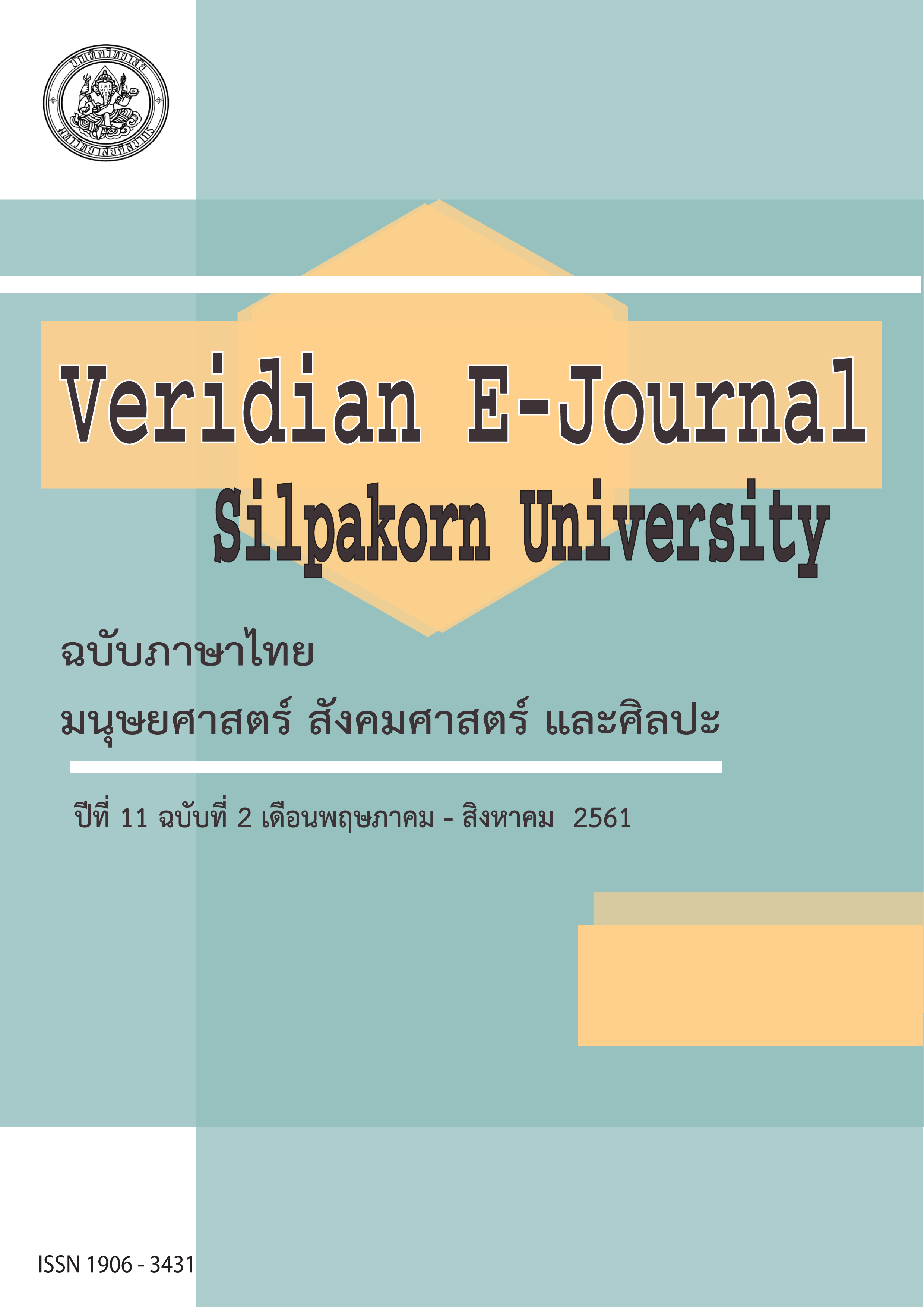การออกแบบแบบฝึกหัดการร้องคอร์ดสเกลที่ใช้ในการเรียนการสอนวิชาทฤษฎีดนตรีแจ๊ส (The Chord Scale Singing Exercise Design for a Jazz Theory Class)
Main Article Content
Abstract
การวิจัยเรื่อง การออกแบบแบบฝึกหัดการร้องคอร์ดสเกลที่ใช้ในการเรียนการสอนวิชาทฤษฎีดนตรีแจ๊ส เป็นลักษณะการวิจัยเชิงคุณภาพ โดยมีวัตถุประสงค์ของการวิจัย เพื่อออกแบบและพัฒนาแบบฝึกหัดการร้องคอร์ดสเกลที่เป็นกิจกรรมการเรียนการสอนวิชาทฤษฎีดนตรีแจ๊ส ในรูปแบบที่ช่วยทำให้ผู้เรียนเข้าใจและจดจำคุณลักษณะเฉพาะของแต่ละโมดได้ง่ายยิ่งขึ้น โดยได้กำหนดขอบเขตการวิจัยของการศึกษาคอร์ดสเกลพื้นฐานที่สำคัญในดนตรีแจ๊ส ได้แก่ บันไดเสียงเมเจอร์ จำนวน 7 โมด บันไดเสียงไมเนอร์แบบฮาร์โมนิก จำนวน 2 โมด บันไดเสียงไมเนอร์แบบเมโลดิก จำนวน 7 โมด และบันไดเสียงสมมาตร จำนวน 3 โมด รวมทั้งสิ้น 19 โมด ผู้วิจัยได้ออกแบบกระบวนการในการวิจัย โดยแบ่งออกเป็น 2 ประเด็น ได้แก่ (1) ทฤษฎีคอร์ดสเกลที่เกี่ยวข้อง และ (2) แนวความคิดในการออกแบบและรูปแบบของแบบฝึกหัด ซึ่งในแต่ละกระบวนการ จะมีความสัมพันธ์และเชื่อมโยงระหว่างกันในทั้ง 2 ประเด็น
สรุปผลการวิจัย แบบฝึกหัดการร้องคอร์ดสเกลที่ใช้ในการเรียนการสอนวิชาทฤษฎีดนตรีแจ๊ส เป็นส่วนหนึ่งของกิจกรรมการเรียนการสอนที่ใช้คู่กับกิจกรรมการบรรยายเนื้อหาทฤษฎีคอร์ดสเกลไปพร้อม ๆ กันในชั้นเรียน แบบฝึกหัดมุ่งเน้นกิจกรรมการร้องคอร์ดสเกลด้วยวิธีคู่ขนาน ระบบสัญลักษณ์โน้ตที่ใช้ในการอ่านโน้ตในแบบฝึกหัด ใช้ระบบบันไดเสียงในรูปแบบตัวอักษรและบันไดเสียงในรูปแบบลำดับตัวเลข ส่วนรูปแบบวิธีการร้องที่ใช้ในการร้องแบบฝึกหัดจะใช้วิธีการร้องพยางค์ไม่เกินช่วงคู่แปด โครงสร้างแบบฝึกหัดการร้องคอร์ดสเกล จะเริ่มจากการฝึกร้องจำแนกองค์ประกอบย่อยของโมด ในส่วนโมดที่มาจากเสียงประสานระบบเมเจอร์ไมเนอร์นั้น ประกอบด้วยเททราคอร์ดล่างและเททราคอร์ดบนแต่ละชนิด หลังจากนั้น ฝึกร้องโดยนำเททราคอร์ดล่างและเท
ทราคอร์ดบนมาผสมรวมกันให้เกิดเป็นโมดที่มีคุณลักษณะเฉพาะที่แตกต่างกัน ในส่วนโมดที่มาจากเสียงประสานระบบบันไดเสียงสมมาตรนั้น เนื่องจากเป็นบันไดเสียงที่ไม่ใช่โน้ตจำนวน 7 ตัว ไม่มีสเกลต้นกำเนิด อีกทั้งมีระบบโครงสร้างขั้นเต็มเสียงและขั้นครึ่งเสียงที่มีสัดส่วนเท่ากัน ดังนั้น จึงใช้ประโยชน์จากความ “เท่ากัน”ของขั้นคู่เสียง มาเป็นองค์ประกอบย่อยของโมด
The purpose of this research was to design and develop the chord scale singing exercises for a jazz theory class to help the students to understand and recognize the characters of the modes at ease. The scope of this research studied the 19 essential common chord scales that are used by jazz musicians. These comprise seven modes in the major scale, two modes in the harmonic minor scale, seven modes in the melodic minor scale, and three modes in the symmetrical scale. The qualitative research methodology included collecting data relating to two main topics: (1) related chord scale theory, and (2) concept of design and format of the exercises.
The result of the final design, which were the chord scale singing exercises for the jazz theory class, were a part of the class activities in conjunction with chord scale theory lectures. The exercises focused on the singing chord scales in a parallel approach. The notation system was letter name system and scale degree numbers, and used syllables for singing, which were limited to one octave. The structure of each exercise began with studying the fragment of the modes that were derived from a major-minor harmonic system divisible into two tetrachords. This was conducted by singing each type of upper and lower tetrachords. Then the upper and lower tetrachords were combined to form a series of eight-note modes. The modes from the symmetrical scales, unlike the seven-note scales, had no parent scale and had their regular interval patterns. Therefore the fragment of the symmetrical scales could be repeated on their symmetrical interval patterns.
